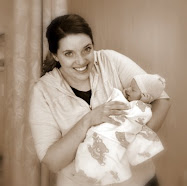"Knowing comes from the place within us that is connected to our source." From A Still, Small Voice by Echo L. Bodine
A month before the due date of my second pregnancy, I had a dream that there were two little girls with pigtails in their hair joining our family. When I told my husband about my dream, he joked, "there had better be only one baby in there. We only have one more bedroom!"
We were planning a homebirth for this pregnancy. Our son had been born at home without complications. In fact, his birth had gone so quickly, that we had barely enough time to fill the birth tub before he emerged. This time, my husband planned to fill the birth tub right away at the start of contractions.
My second pregnancy was "normal" as far as anyone could tell. I had regular prenatal care with my midwife and our family practitioner. Both felt I was a fine candidate for a second home birth, and that ultrasound wasn’t necessary for me. I measured a little big, but that had been the case with my son as well. Several people joked to me about possibly carrying twins, yet when my practitioners checked me, they both only heard one heartbeat. As part of our preparation for birth, we reviewed the "Emergency Childbirth" pamphlet from our midwife, and consciously visualized a positive birth outcome.
A week before my due date, my husband and son set up the rented birth tub in our home. When I saw the tub sitting there ready to go, I felt a spasm of fear for what was to come. My husband held me as I cried out my fears, and as the tears subsided, the fear was still real to me, but from the bottom of my heart I knew that everything would turn out alright.
Early on the morning of my due date, I woke my husband, David, to tell him that contractions had begun. He immediately called my mom and the midwife, and started to fill the birth tub. After a few contractions I needed David to put pressure on my low back. Between contractions he opened our birth kit, adjusted the faucet temperature, and gave me sips of water. As soon as the tub was deep enough I climbed in. It was much easier to handle the contractions in the water.
Nevertheless, I suddenly needed to roar through the contractions. I made deep, low moaning noises. I started crying. I knew I was in transition from the emotions that were flowing. I felt like pushing, and started to blow air through my mouth to hold back until the midwife could arrive. I needed to squat. I panted, blew air, and then started pushing because there was no way not to push. David briefly wondered where the midwife was. After a couple of pushes the baby came out all at once. We gently lifted her up out of the water and held her close. While we tried to start nursing I felt strong contractions resume, and again experienced the urge to push. I reached down and felt a second head with my fingertips.
Now, instinctively, I knew it was a second baby, and my body knew exactly what to do, though this certainly wasn't planned! I softly cradled Baby 1, as I squatted and pushed. It was easier this time, and after two pushes Baby 2 shot out into the water. Her head was covered with the sac. David removed the membranes and lifted her to my other breast.
The babies were slippery, and my arms were coated with vernix. As Baby 2 latched on to nurse, finally both the midwife and my mom arrived at the same time. We were all in a state of shock and disbelief. My midwife consulted the clock and realized that my labor had lasted less than 50 minutes. We weighed the babies: 5 lbs. and 5 lbs. 12 oz. The placenta weighed 8 ½ pounds!
While I dozed in bed with the babies, I remembered the dream about the two little girls with pigtails in their hair. I realized then, that deep down, on some level, I had known all along that I had been carrying twins. The pieces fell into place as I relived my pregnancy with this new information. No wonder I had felt so tired!
My family was incredulous. Each visitor who stopped by with good wishes needed to see both of the babies to believe that there really were two of them. Every time I looked at the twins I was full of wonder. Most of all I was euphoric: I had handled the birth by myself, twins or not, and it had gone beautifully. Everything had turned out just fine.
Over time, I have realized, with much gratitude, how we had been living in a protected space during the twins' pregnancy and birth. I believed my care providers who told me that I was carrying a singleton. I trusted in my strength as a woman to give birth, and I trusted my body to tell me what I needed to know, and to do what needed to be done. In not noticing the signs that I was carrying twins, I was able to view my pregnancy as completely normal. And I was free of the interventions that are standard in multiple pregnancies and births today, such as bed rest, fetal testing, continuous monitoring, and obligatory c-sections.
Now that my twins are four, I find I am still processing their birth mentally, emotionally and spiritually. As the haze of hormones has lifted, I see that their birth was a blessing on many levels.
I feel blessed to have been held in a bubble of safety, in not being conscious of the fact that I was carrying twins. I feel so fortunate to have been surrounded by care providers who believed in me and in the birth process. And I feel privileged to have experienced my own power during unassisted homebirth. I believe that things happen for a reason, and I attribute this experience to the work of the Divine.
The birth process taught me that I have inner wisdom and my twins' births gave me further impetus to explore my intuition. After the birth of my twins I had an awakening of the soul. I came to respect the power of my intuition, and have since decided to use it and cultivate it more. This "knowing", which Echo Bodine talks about in her book A Still, Small Voice, has connected me to my calling: planning and facilitating gatherings of women and girls to honor life's passages as sacred. My intuition told me that women's life passages, like pregnancy, birth, coming of age, and loss, need to be honored and celebrated.
The legacy of my twins' births is my conviction to tell this birth story again and again. Not only because I am an example of uncomplicated, unassisted homebirth of unexpected twins, but also because by sharing my story, I honor this passage and my body's message to me. And these are some of the many blessings of homebirth.


